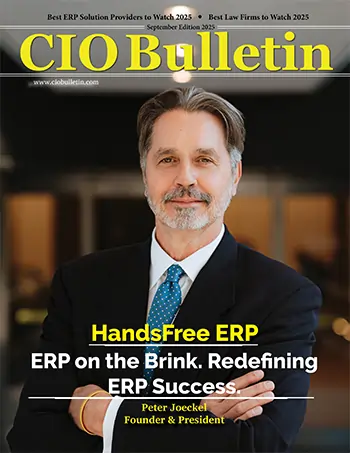50 Best Companies to Watch 2021
CIO Bulletin

In the business world, uncertainty and change are constants. Given that this is the case, adaptability is a critical characteristic of successful businesses. Within the finance function, CFOs must confront this reality and stay agile by embedding advanced data management capabilities and adopting solutions that can help them stay on top of business conditions in real-time.
Access to better-aggregated cross-organizational data can help the c-suite make better decisions and improve services. This is where cloud FP&A solutions come in, as these software increase efficiency and data accuracy in finance by enabling companies to measure and analyze their past performance to make better business decisions
However despite their myriad of benefits, most finance functions tend to forego adopting such systems and instead choose to continue relying on Excel. Didi Gurfinkel, CEO of DataRails, witnessed this resistance during his time at Cisco. While working at Cisco, Gurfinkel saw how such a big and established organization was conducting critical financial processes on Excel spreadsheets. Despite being an organization that could afford to purchase any available solution in the market, Cisco continued to use Excel spreadsheets for their critical processes. He realized that there must be a better way to approach and tackle the problem of data aggregation. That’s when he decided to try to turn Excel into an enterprise-grade tool, and how DataRails came to life.
DataRails allows organizations to move towards working with a cloud-based financial product, all while end-users continue working on their usual Excel files as they have up until now. The solution connects to all organizational systems including ERPs, CRMs, HRISs, as well as complex Excel files, and consolidates all of this data in one cloud-based database. With DataRails, finance professionals can conduct advanced investigations into their data to extract formerly unattainable insights and enjoy a 360-degree view of all unified organizational data, all while continuing to work in Excel as they’re used to. The modern finance function needs to be able to transform loads of information into actionable insights, and DataRails allows them to do just this. We interviewed Didi Gurfinkel, the Co-Founder and CEO of DataRails, to learn about the company and its services better. Here are a few excerpts of the interview:
Q. What is the importance of financial analysis for SMEs? What is your approach towards making it more efficient?
Small and medium-sized businesses are characterized by rapid changes and the need for agility, and their ability to survive and grow depends on their ability to adapt themselves to changing circumstances. To succeed, they must be able to conduct quick adjustments so that they may, in the end, find the right way to propel themselves forward. The role of the finance department and the CFO’s office is to help decision-makers understand what they did well and what they didn’t. Thanks to various analyses, they can understand what would happen if they continued along the same path or what would happen if they chose to do things differently to improve their financial stance. That’s why beyond the preparation of financial reports and understanding how much was made and how much was lost, it’s essential to understand why things happened.
An organization that can successfully and quickly understand what it needs to do to improve, one that understands where it’s doing well and where less so, will be able to push forward while others will fall behind. In SMEs, the pace of change is high, there is a lack of manpower, and there are always lacking resources. As a result, finance professionals are usually forced to settle for dry financial numbers and less of a deeper understanding of data.
In terms of efficiency, DataRails comes in by introducing automation. There’s great importance in getting numbers on demand and not just in the middle of a quarter or month, but instead getting them fast and frequently. Second, the ability to analyze numbers is crucial. Today organizations are so busy simply organizing data that in the end, they reach a relatively simplified answer-they don’t have the time or resources to start analyzing. DataRails’ reporting abilities say ok, let’s make it automatic- on the one hand, customers retain the flexibility of work on Excel and spreadsheets to allow for agility. On the other hand, we provide robustness and strong analysis abilities thanks to databasing capabilities. This way, users enjoy the best of both worlds.
Delineate DataRails’ innovative financial analysis platform and its significance.
DataRails doesn’t replace the models, the developments, the Excels, and analyses that already exist within the organization. Rather, we automate processes- we allow all the data work to be done within the database and then add atop automation and strong analysis capabilities. We don’t change the base-we use your assets, IP, financial models, and templates that exist within the organization, but also allow processes to be improved significantly.
Q. What are the advantages of DataRails’ platform compared to traditional financial analysis?
DataRails allows for the continued use of the familiar platform of Excel and the same models, spreadsheets, P&Ls, Balance Sheets, and analyses that already exist and have been developed by organizations over the years. They continue to exist, but there is a database that is created underneath. The numbers come directly and automatically from the database, all while maintaining the flexibility of existing processes.
Q. Companies must be aware of the potential challenges and how to tackle them before making the step into the Intelligent Automation sphere. How do you manage to keep your clients fully aware of the automation challenges? Do you promise results?
Our entire approach decreases risks that arise from moving from a system that has been running for a long time to a new system. We significantly minimize the risk in that we retain all existing data structures, templates, and models, all the ways of reporting. We build the automation behind the scenes. So instead of moving data manually, the data moves through the database, and users continue to use the same tools they’re used to (Excel and PowerPoint). For the end-user, the working environment barely changes. And given that DataRails is a financial system, there are a lot of validations and monitoring that goes on.
Q. What do you feel are the reasons behind your company’s success?
It begins with our groundbreaking technology and extends to our unique product, as well as our go-to-market that is suitable for SMBs and for places that are risk-averse and typically resist change.
Q. Automating a financial analysis process requires lots of rational and smart thinking. How do you maintain efficiency in your service?
We use the brainpower, IP, and assets that our customers already have. We don’t try to reinvent the financial model, but rather connect between data sources and existing models.
Meet the CEO
Didi Gurfinkel is the Co-Founder and CEO of DataRails. Gurfinkel began his journey as a Software Engineer and progressed to more senior roles including Team Lead and VP R&D. He later moved on to more managerial roles- first as COO and then as a GM at Cisco, where he led a big business unit. At Cisco Gurfinkel saw how such a big and established organization was conducting critical financial processes on Excel spreadsheets, and this is where the idea behind DataRails was born.
“Switching to DataRails was like wearing glasses for the first time. Suddenly everything was sharper, clearer, and made more sense,” Rob Grasso, Director of Global Sales Operations, Bauer Hockey.







